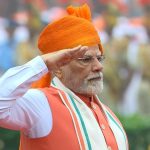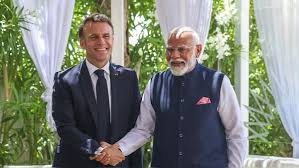
IRAN TRUMP ERA
For some years now, India has liked to think of itself as a “leading power” rather than simply a “balancing power”. But if the Modi government’s response to Donald Trump reneging on the Iran nuclear deal is anything to go by, India may find itself being classed among the craven powers.
It is not surprising that in the run-up to the decision, Trump met French president Emmanuel Macron and German chancellor Angela Merkel on the issue and spoke to British prime minister Theresa May. He didn’t speak to Xi Jinping and Vladimir Putin because China and Russia’s stands are well known. But he did not bother to consult Prime Minister Narendra Modi, the leader of a country which is a close ally of the US and stands to lose a great deal from the decision. This is because Trump knew he could take India for granted; after all, the Modi government’s weak-kneed approach was evident when it avoided substantial comment on the US shifting its embassy to Jerusalem.
India’s official statement on Trump’s Iran decision began with the non sequitur that Iran’s right to peaceful uses of nuclear energy should be respected, that the issue should be resolved through dialogue and diplomacy. “All parties should engage constructively to address and resolve issues that have arisen with respect to the JCPOA,” the MEA said, using the acronym for nuclear agreement’s formal name, the Joint Comprehensive Plan of Action.
There was, unlike the Chinese statement, no expression of regret that an international agreement which had the mandate of a UN Security Council resolution and whose termination has profound implications for the stability of a region which is, arguably, the most important external region for India, had been terminated so wantonly.
The issue is not about Iran’s right to the peaceful uses of atomic energy, but about ensuring that it does not develop nuclear weapons. The JCPOA is not some treaty that is under negotiation, but as the Russian statement pointed out, it is “a key multilateral agreement approved by the 2015 UN Security Council Resolution 2231.” In other words, it has the force of international law.
The US which frequently swears by the “rule of law” now says it is “withdrawing”, not “violating” the JCPOA because it goes against its strategic interests. Mind you, this is a treaty in which the then Obama Administration was the lead negotiator. National security adviser John Bolton declared, on May 8, that “any nation reserves the right to correct a past mistake.” To this end he cited the Bush administration’s withdrawal from the 1972 ABM Treaty, which he said the Americans abandoned not because the Russians were violating it, “but because the global strategic environment had changed.” The Trump administration earlier withdrew from the Paris climate accord, presumably because it does not serve its strategic interests.
This, of course, is a catch-all which can justify China trashing the arbitration award on the South China Sea under UNCLOS in 2016, or any future Indian decision to scrap the Indus Waters Treaty of 1960, or for the Iranians to simply walk out of the Nuclear Non-Proliferation Treaty as the North Koreans did in 2003.
Everyone else – the Europeans, the Chinese and even the UN watchdog IAEA– says Iran is conforming to its obligations there. But what the US is saying is that not only must Iran implement the letter of the JCPOA, which seeks to prevent them from developing nuclear weapons, but must also meet other demands made by the US, Israel, Saudi Arabia and all their allies, as though it is a defeated nation. So it must not have ballistic missiles, it must not support insurgents in other countries – even while the US, the Saudis, Emiratis and Saudis are free to do so. Israel, of course, can do what it likes. It can possess nuclear weapons, ballistic missiles and militarily occupy another state and repress its people. In short, the US wants to decide who is going to be a power in the Middle East by dictating the manner in which countries can arm themselves.
As of now, according to Bolton, sanctions come into effect immediately insofar as new contracts are concerned. As for the older ones, they need to be phased out between three to six months. There is little doubt that the US action will create a great deal of needless turmoil and possibly, war. It is bound to give Russia and China greater room in the region. Europe is in a dilemma, even though it supports the JCPOA and has criticised the American “withdrawal”, the reality is that its exports to Iran – worth $400 billion – are dwarfed by the $18 trillion worth of goods and services it sells to the US every year.
China has shielded Iran from the effects of previous rounds of sanctions, and there is little doubt that it will continue to do so now. Not many know that Beijing has had an active presence in Iran for the past 30 years. Iran has been the largest recipient of Chinese foreign assistance in the 2001-2014 period, some $143 billion. China is Iran’s biggest economic partner and customer of oil. It is playing a major role in aiding Iran’s oil exploration and infrastructure construction. Xi Jinping was the first visitor to Tehran when sanctions were lifted in 2016 and the decision taken to raise bilateral trade to $600 billion in 30 years from a figure of around $40 billion today.
China is a major supplier of weapons to Tehran and has helped set up its military-industrial sector, including the establishments that fabricate missiles. But it has also played and continues to play a major role in developing its railway system by building everything from rails to manufacturing wagons. Iran is an important way station in Beijing’s Silk Road Economic Belt route to Europe. As part of this, the first train from Yiwu arrived in Tehran in February 2016; since then several more trains have done the route. A Chinese company is electrifying the railway track between Tehran and Mashad, from where it goes on to Turkmenistan and China. An ambitious project will see the Iranian system link to the Turkish one to carry freight through the Bosporous tunnel to Europe.
Where does that leave India ? Between a rock and a hard place. The Persian Gulf region is by far the most important external region for the country. Iran is the closest major source of hydrocarbon energy to the Indian land mass. Iran is India’s third largest supplier of oil after Iraq and Saudi Arabia, prior to the sanctions it was number two. Iran supplied 18.4 million tonnes in the April 2017-January 2018 period and the year before that as much as 27.2 million tonnes.
The issue of oil trade with Iran or the future of Chabahar is not our primary concern, but the very stability of the larger region that provides us over 60% of all our oil, where nine million Indian citizens work and send back $40 billion in remittances from what is the largest single external source.
The regional stability India seeks there is built on carefully nurtured relationships between the various antagonistic powers there — Saudi Arabia, the UAE, Qatar, Israel and Iran. One of its most important recent pillars was the carefully crafted JCPOA, a measure aimed at normalising Tehran’s relation with the West (and their regional allies) by ensuring that it winds down its capacity for making nuclear weapons.
India’s bilateral trade is around $13 billion currently and it has committed some $500 million on the Chabahar port project and has also said it would fund the $1.6 billion rail link between Chabahar and Zahedan. There are ambitious plans to invest in gas-based fertiliser and other projects in a special economic zone that is planned around Chabahar. But there is little doubt that US sanctions will become a major impediment here.
There is an aspect of India’s relationship with Iran which goes beyond oil and energy. It is related to business opportunities in the country, as well as connectivity schemes through it to Afghanistan and Central Asia via Chabahar and Europe through the International North South Transportation Corridor originating in Bandar Abbas.
Indeed, ties with Iran are important for India’s emergence as the “leading power” that it aspires to be. However, it may soon have to choose between its strategically autonomous goals and those which the Trump administration has in mind for the region.
With his ill-considered action, Donald Trump may trigger a war which could be more destructive than the American invasion of Iraq in 2003. But almost certainly what it will do is to promote a major geopolitical shift that could catalyse the political and economic integration of a vast Eurasian region from Vladivostok to Baghdad and Moscow under Chinese auspices, rivalling the Mongol empire at its zenith.
Courtesy:ORF
Author Profile
Latest entries
 India and the WorldAugust 16, 2025Notes for a Prosperous Bharat By Narendra Modi
India and the WorldAugust 16, 2025Notes for a Prosperous Bharat By Narendra Modi DiplomacyMarch 31, 2021Heart of Asia: Jaishankar calls for ‘double peace’ in Afghanistan
DiplomacyMarch 31, 2021Heart of Asia: Jaishankar calls for ‘double peace’ in Afghanistan India and the WorldSeptember 11, 2020India, China forge 5-point formula to defuse border crisis
India and the WorldSeptember 11, 2020India, China forge 5-point formula to defuse border crisis India and the WorldJanuary 8, 2019India-Nordic Connect: New Horizons
India and the WorldJanuary 8, 2019India-Nordic Connect: New Horizons







